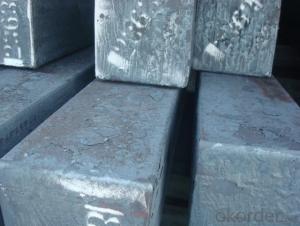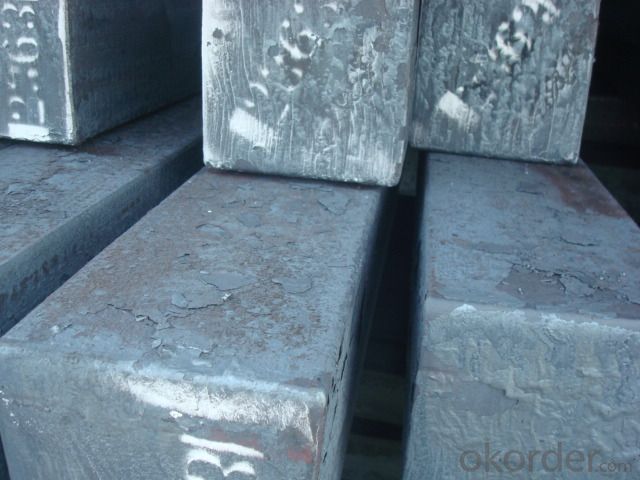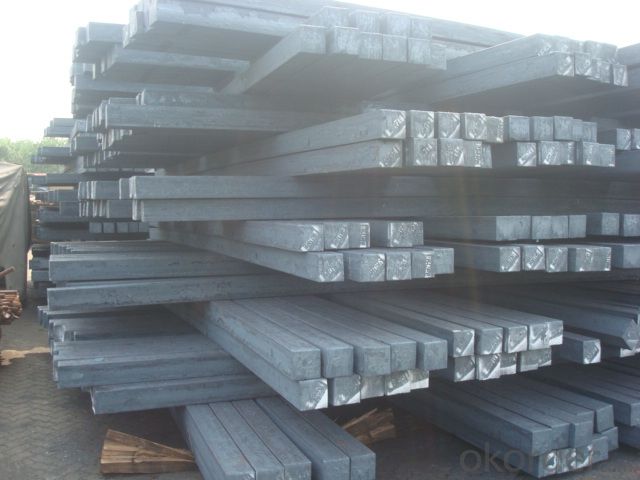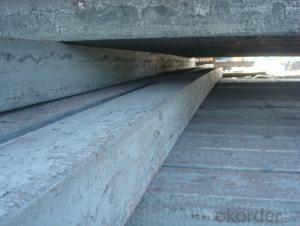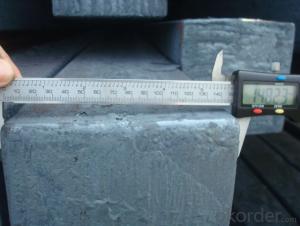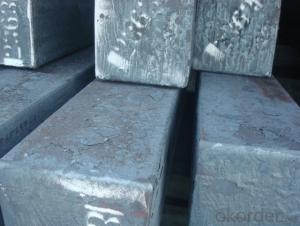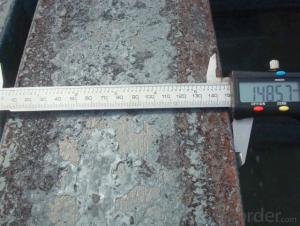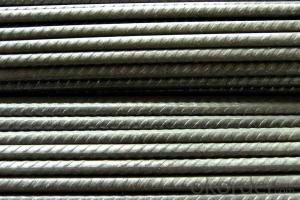Steel Billet Manufactured by Blast Furnace
- Loading Port:
- Tianjin
- Payment Terms:
- TT OR LC
- Min Order Qty:
- 25 m.t.
- Supply Capability:
- 100000 m.t./month
OKorder Service Pledge
OKorder Financial Service
You Might Also Like
Steel Billet Manufactured by Blast Furnace
1.Structure of Steel Billet Manufactured by Blast Furnace
Steel Billet Manufactured by Blast Furnace is the raw material of all kinds of steel mill. Billet section of square, round, flat, rectangular and abnormity, etc Several, mainly related to shape of rolled products. Simple rolled section steel, choose cross section of square billet or rectangular billet. rolling The sector products such as flat steel, Angle steel, select the rectangular billet or slab. Had better profiled billet when production beams, channels, and in rolling process Lines and improve the yield. The raw material of round billet is the production of seamless tube.
2.Main Features of Steel Billet Manufactured by Blast Furnace.
Steel Billet Manufactured by Blast Furnace section size should meet the requirements of rolling deformation and finished product quality, but also roll strength and biting condition of restrictions. General steel Billet section height H. And the roll diameter D The ratio of the ( namely H/D) Should be less than or equal to zero 0.5 . Length of steel billet by finishing temperature, Rolling time and the length of the product Or times ruler. When heated too long accident prone to bump the furnace wall of steel, too short, furnace bottom utilization rate is not high, influence the heating furnace production. For the production Choose a variety of steel and steel billet, should consider the affinities of billet, as far as possible in order to improve the productivity of the roughing mill, simplify the stock management of workshop.
3. Steel Billet Manufactured by Blast Furnace Images
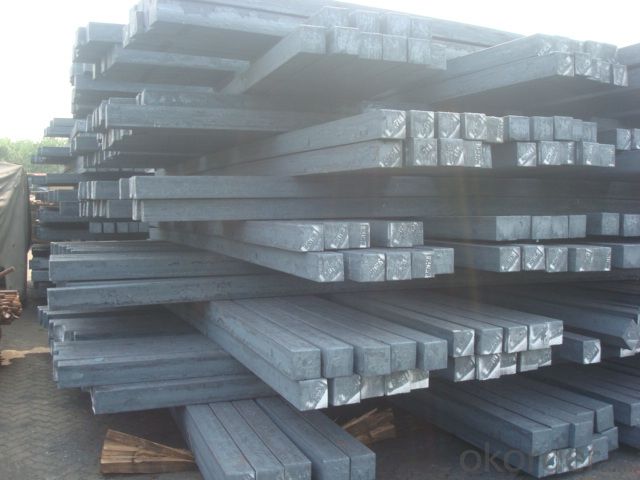
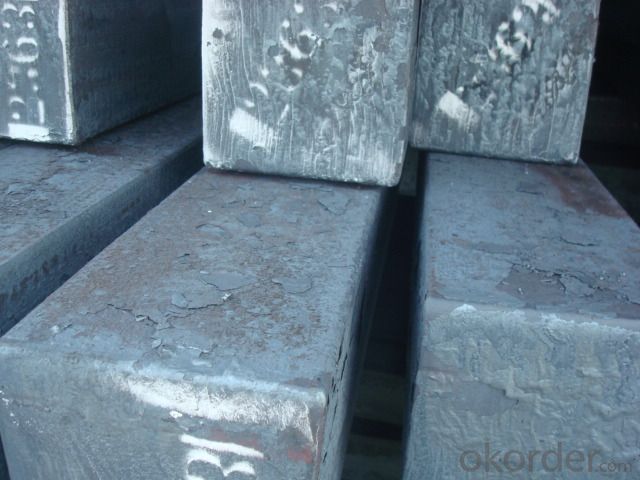
4. Steel Billet Manufactured by Blast Furnace Specification
Steel Billet Manufactured by Blast Furnace rolled steel, after processing can be used for mechanical parts, forging parts, processing all kinds of steel, steel Q345B channel steel, wire rod is the role of the billet. Steel billet is used in the production of semi-finished products, generally cannot be used directly for the society. Steel billets and steel are strictly divided into standard, cannot decide to whether the business enterprise of the final product, and according to unified standards to perform the whole society. Typically, billet and the steel is relatively easy to distinguish, but for some steel billet, and have the same specification and same steel purposes (such as rolling tube billet), whether can be used for other industries, whether through steel processing process, whether through a finished product rolling mill processing to distinguish
Material standard The editor Range of thickness: 150-240 - mm + / - 5 mm width range: 880-1530 - mm + / - 20 mm Length: 3700-10000 - mm + / - 500 - mm Cross-sectional size: 64 * 64; 82 * 82; 98 * 98; 124 * 124; 120 * 150; 152 * 164; 152 * 170 mm Length: 9000 mm Section of tolerance: billet: 1.0 + / - 2.0-1.0 + / - 1.0 mm slab: width: + / - 2.0 mm thickness: + / - 3.0 mm The length tolerance: + / - 200 mm Section diagonal tolerance: 3.5-8.0 MM Billet section size protrusions requirements: < 1242 mm, do not allow; > = 1242 mm, < = 2 mm 1242 mm, < = 3 mm Beheading (shear) extension deformation: < 1242 mm billet: no control; The slab: < = 15 mm Surface tilt: no more than billet section 0.1 Bending: every 1 m length is not more than 10 mm The distortion: length < = 5 m, < = 11. ; The length of the < = 7.5 M, < = 5. Material % 3 sp/PS chemical composition: C Mn Si S P
5.FAQ of Steel Billet Manufactured by Blast Furnace
We have organized several common questions for our clients,may help you sincerely:
①How about your company?
A world class manufacturer & supplier of castings forging in carbon steel and alloy steel,is one of the large-scale professional investment casting production bases in China,consisting of both casting foundry forging and machining factory. Annually more than 8000 tons Precision casting and forging parts are exported to markets in Europe,America and Japan. OEM casting and forging service available according to customer’s requirements.
②How to guarantee the quality of the products?
We have established the international advanced quality management system,every link from raw material to final product we have strict quality test;We resolutely put an end to unqualified products flowing into the market. At the same time, we will provide necessary follow-up service assurance.
③How is the packaging and delivery?
Exporting Package with the steel material cover and the delivery term is based on the project.
- Q: What are the main advantages of using steel billets in manufacturing?
- Using steel billets in manufacturing offers numerous advantages. Firstly, their exceptional strength and durability make them ideal for producing products that require high tensile strength and resistance to wear and tear. Whether it's automotive parts, construction materials, or industrial equipment, steel billets provide the necessary strength and reliability. Secondly, steel billets offer excellent machinability, allowing them to be easily shaped, cut, and formed into different shapes and sizes. This versatility in manufacturing processes enables the creation of complex and intricate designs with precision, ensuring the production of high-quality finished goods. Furthermore, steel billets possess excellent thermal conductivity and can withstand extreme temperatures. This makes them valuable in industries that require heat resistance, such as the production of heat exchangers, boilers, and other industrial applications. The ability of steel billets to maintain their structural integrity even under high temperatures makes them highly reliable in demanding manufacturing environments. Additionally, steel billets are readily available and cost-effective. Steel is widely used in manufacturing, making it easily accessible in the market. The abundance of steel billets ensures a consistent supply, reducing production delays and costs associated with sourcing materials. Lastly, steel billets have excellent corrosion resistance, making them suitable for manufacturing products exposed to harsh environmental conditions or corrosive substances. By utilizing steel billets, manufacturers can ensure that their products maintain their integrity and functionality even in challenging environments. To conclude, the main advantages of using steel billets in manufacturing include their exceptional strength, machinability, thermal conductivity, availability, cost-effectiveness, and corrosion resistance. These qualities make steel billets the preferred choice for various industries, enabling the production of high-quality, durable, and reliable products.
- Q: How are steel billets used in the manufacturing of railway wagons?
- Steel billets are used in the manufacturing of railway wagons as they serve as the raw material for various components such as frames, side panels, and undercarriages. These billets are first heated and then shaped into the desired form through processes like rolling or forging. The resulting components are strong, durable, and able to withstand the rigorous demands of railway transportation, ensuring the safety and reliability of the wagons.
- Q: What is the role of steel billets in the construction of offshore platforms?
- Steel billets play a crucial role in the construction of offshore platforms. These platforms are massive structures that are installed in the open sea to extract oil or gas from beneath the ocean floor. Due to the harsh environmental conditions and the need for utmost safety and durability, steel billets are widely used in their construction. One of the primary functions of steel billets is to provide the raw material for the fabrication of various components of offshore platforms. Billets are large, semi-finished steel products that are typically used as starting material for the production of other steel products. They are cast into a specific shape, usually a square or a rectangle, and have a solid cross-section. Offshore platforms require steel with exceptional strength, corrosion resistance, and impact toughness to withstand the challenging conditions they face, such as strong waves, harsh weather, and extreme temperatures. Steel billets are often made from high-strength alloyed steels, which offer superior mechanical properties and resistance to corrosion. These billets are then further processed to manufacture different structural elements of offshore platforms, including beams, columns, braces, and other support structures. These components must be able to support the weight of the platform itself, as well as withstand the forces generated by ocean waves, wind, and the extraction process. Moreover, steel billets are also used in the production of pipes and tubes, which are vital for transporting oil and gas from beneath the seabed to the platform or to the shore. These pipes need to be strong, durable, and resistant to corrosion to ensure the safe and efficient flow of hydrocarbons. In summary, steel billets serve as the building blocks for the construction of offshore platforms. They provide the raw material for fabricating various structural components, ensuring the strength, durability, and safety of these massive structures in the challenging offshore environment.
- Q: Can steel billets be used for decorative purposes?
- Yes, steel billets can be used for decorative purposes. Steel billets are the raw material used for various applications in the steel industry, including the production of decorative products. By applying various techniques such as forging, casting, or machining, steel billets can be transformed into aesthetically pleasing decorative items such as sculptures, ornamental gates, furniture, architectural elements, and more. The versatility and durability of steel make it a popular choice for decorative purposes, as it can be shaped into intricate designs and withstand outdoor conditions. Additionally, steel can be further enhanced with various finishes, such as painting, powder coating, or patina, to enhance its visual appeal and complement different styles or aesthetics.
- Q: What are the environmental impacts of producing steel billets?
- The production of steel billets has various environmental consequences. One of the primary concerns lies in the emission of greenhouse gases, particularly carbon dioxide (CO2), during the steelmaking process. Steel production significantly contributes to global CO2 emissions due to the high temperatures and the utilization of fossil fuels like coal or natural gas to extract iron from iron ore. The combustion of these fuels releases CO2 into the atmosphere, thereby contributing to climate change. Another environmental impact associated with steel billet production is the generation of air pollutants. The use of fossil fuels in steelmaking can lead to the release of sulfur dioxide (SO2), nitrogen oxides (NOx), and particulate matter, which contribute to air pollution and can negatively affect human health. Moreover, the production of steel billets often involves the use of additives and chemicals, which can further contribute to air pollution if not appropriately managed. The extraction of iron ore, a primary raw material for steel production, can also have significant environmental implications. Mining activities can result in deforestation, habitat destruction, and soil erosion. Additionally, the extraction and transportation of iron ore necessitate the use of heavy machinery and vehicles, consuming energy and contributing to air pollution. Water usage is another environmental concern in the production of steel billets. Steelmaking processes require substantial amounts of water for cooling, cleaning, and dust suppression. The extraction and treatment of water, as well as the discharge of wastewater, can have adverse effects on local water sources, particularly if not properly managed or treated. Lastly, the production of steel billets generates waste and by-products. Steel slag, a by-product of the steelmaking process, can contain heavy metals and other pollutants. If not adequately treated or disposed of, these by-products can contaminate soil and water resources. In summary, the production of steel billets has significant environmental impacts, including greenhouse gas emissions, air pollution, water usage, and the generation of waste and by-products. Efforts are being made to mitigate these impacts through the development of cleaner and more energy-efficient steelmaking technologies, increased utilization of recycled steel, and improved waste management practices in the industry.
- Q: I want to buy a fishing pole, I don't know how to distinguish it. Know what, please reply, thank you, [em10]!
- The tonality of a fishing rod is actually modulated by a different modulus of carbon cloth.Some fishing overall with the 30T following carbon cloth, just use a very small amount of 40T or 46T carbon cloth, called high carbon rod, is actually confuse the public practice of fishing by weighing, hand identification, high carbon rod with real light, hard, two rods in a play, a ratio is obvious.
- Q: How are steel billets tested for internal defects?
- Steel billets undergo various non-destructive testing methods to check for internal defects. Ultrasonic testing (UT) is a commonly used method. It involves transmitting high-frequency sound waves into the billet and analyzing the reflections to identify cracks, voids, or inclusions. UT provides accurate information about the defects' size, location, and nature. Magnetic particle inspection (MPI) is another method employed. It magnetizes the billet and applies iron particles to its surface. If there are internal defects, the magnetic field causes the particles to gather around them, making them visible and detectable. Eddy current testing (ECT) is also used to assess the internal quality of steel billets. It creates eddy currents within the material using electromagnetic induction. Any changes in electrical conductivity or magnetic permeability caused by internal defects are detected by analyzing the induced current's variations. Radiographic testing (RT) is additionally utilized to inspect the steel billet's internal structure. X-rays or gamma rays are directed towards the billet, and the resulting radiographic image reveals voids, cracks, or inclusions. Dye penetrant testing and visual inspection can be used to detect superficial and near-surface defects. These methods involve applying liquid or dye to the billet's surface, which seeps into cracks or surface irregularities, making them visible under specific lighting conditions. Overall, a combination of these non-destructive testing methods ensures the quality and integrity of steel billets. They effectively detect any internal defects that could compromise the billet's structural integrity and performance.
- Q: Can steel billets be used for making tools?
- Yes, steel billets can be used for making tools. Steel billets are raw metal blocks that can be further processed and shaped into various tools through techniques like forging, machining, and heat treatment. The high strength and durability of steel make it an ideal material for tool manufacturing, as it provides the necessary hardness, toughness, and resistance to wear and tear.
- Q: What is the average lead time for ordering steel billets?
- The lead time for ordering steel billets can vary depending on several factors, including the supplier, quantity needed, production capacity, and current market conditions. Typically, the lead time can range from a few weeks to a couple of months. If the supplier has readily available stock or a short production cycle, the lead time may be shorter, usually around two to four weeks. However, if the supplier needs to produce the steel billets specifically for the order, it may take longer. In such cases, the lead time can extend to six to eight weeks or even longer, particularly if there are any production process delays. Considering the quantity required is also crucial. Smaller orders may have shorter lead times compared to larger quantities, as they can be accommodated within the supplier's existing production schedule or available stock. Furthermore, market conditions play a significant role. When there is high demand or disruptions in the supply chain, lead times may increase due to heightened competition for resources and longer production cycles. To obtain an accurate estimate of the average lead time for ordering steel billets, it is advisable to contact multiple suppliers and discuss your specific requirements with them. They can provide more precise information based on their production capabilities and the current market conditions.
- Q: What is the lifespan of steel billets?
- The lifespan of steel billets varies depending on various factors such as storage conditions, environmental exposure, and usage. However, with proper handling and maintenance, steel billets can last for several years to decades.
Send your message to us
Steel Billet Manufactured by Blast Furnace
- Loading Port:
- Tianjin
- Payment Terms:
- TT OR LC
- Min Order Qty:
- 25 m.t.
- Supply Capability:
- 100000 m.t./month
OKorder Service Pledge
OKorder Financial Service
Similar products
Hot products
Hot Searches
Related keywords
